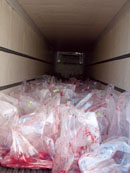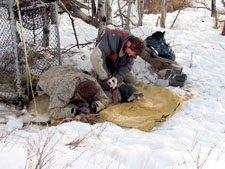|
 |
There has been much discussion regarding Alberta’s CWD control efforts in the eastern part of our province. Many residents living and hunting in those areas—deemed “CWD Zones” by our Fish and Wildlife division—are concerned and upset over the culling program currently taking place this spring. Many believe that culling entire deer herds will have little effect on the spread of CWD but will rather hurt local economies and eliminate favoured hunting grounds. Others, including our Fish and Wildlife division, believe that culling populations of deer in infected zones is the only way to control the spread of this disease.
 |
| Officer Todd Ponich is shown here tagging a deer taken during the CWD cull. - Photo courtesy of Alberta Fish and Wildlife. |
According to Lyle Fullerton, Information Officer for Fish and Wildlife, there is no other known way of controlling the spread of CWD.
“If we are going to control CWD, there is no other option. This is the best information we have North America wide. The only known way to control CWD is depopulation, and herd reduction.”
The small villages of Edgerton and Chauvin, Alberta are well-known in hunting circles for their outstanding populations of white-tailed deer and mule deer. Unfortunately for Chauvin, home of the world’s largest softball, this high deer population, combined with their proximity to Saskatchewan, leaves them vulnerable to the ravages of chronic wasting disease.
Both villages reside within WMU 234 where three new cases of CWD were confirmed in wild deer this past fall.
According to Chauvin Councilor Jack Goodall, a hunter himself, his village will indeed feel the economic repercussions of the cull currently taking place as early as the upcoming 2007 hunting season.
“Absolutely it’s going to affect us. Who is going to come hunting here if there are few or no deer?”
But according to Chauvin Mayor Velda Nutbrown, the cull is currently proving to be very economic.
“Right now it’s not impacting us. The restaurant in town is feeding forty Fish and Wildlife officers a day.”
But the fact remains, when Fish and Wildlife pull up stakes after completion of their cull program, Chauvin will be left to its own devices.
“It’s unfortunate that it’s our area that’s being impacted,” said Goodall. “But I guess it’s better to take measures now rather than have the disease spread across the province.”
And that is exactly how our Fish and Wildlife division feels.
 |
| Meat from culled deer is salvaged. - Photo courtesy of Alberta Fish and Wildlife. |
“CWD is a serious threat to Alberta’s deer population,” said Lyle Fullerton, who took the time to return my call from Fish and Wildlife’s main base of the culling operations. “We understand the public’s concern. We are concerned.
“The public has to understand; we don’t want to do this, but we have no other options.”
The infected deer discovered near Edgerton is the westernmost case of CWD found in Alberta. Which doesn’t bode well for those deer who reside at CFB Wainwright or the nearby Wainwright Dunes Ecological Reserve. Deer populations in these two areas are very high and very close to the Edgerton infected deer. Should CWD in fact continue its spread west and into these areas, larger, more extreme culls may have to take place.
Managing chronic wasting disease is a difficult task, yet one that must be taken. However, in some areas, namely Nebraska and Wyoming where CWD is endemic, culling is not an option as those jurisdictions view depopulation as unattainable because of the prevalence of the disease.
In Alberta, however, chronic wasting disease has yet to become endemic, meaning we still have depopulation of deer left as an option to control the spread of the disease. According to Fullerton, we are lucky that’s the case.
“All of the animals we’ve tested, except one, have proven to be at a very early stage of the disease,” said Fullerton, who admits the job undertaken by Fish and Wildlife is not a pleasant one. “This tells us that we are at the threshold of the disease. That puts us in the best position in North America to control its spread.”
In a joint venture with the University of Alberta, both Alberta Fish and Wildlife and Saskatchewan Environment are participating in a program titled The Border Deer Study. The purpose of the study is to “help identify the potential epidemiological risk of CWD entering and spreading into Alberta along portions of the Saskatchewan border."
 |
| More than 125 deer were collared in WMU 234 for study purposes. - Photo courtesy of Alberta Fish and Wildlife. |
The main focus area of the study is WMU 234 where it is believed that local deer travel from their summer ranges in Saskatchewan into wintering ranges in Alberta. The study hopes to determine which deer populations are at risk to CWD by examining their movement patterns through collaring and genetic studies. According to “Deer Tracks”, the newsletter of the Border Deer Study: “As deer move between regions, they bring their unique genetic material with them. Consequently, if many deer are moving between areas, the deer within these regions will appear genetically similar due to this mixing of the deer and the genetic material they contain.”
The samples being used for the genetic studies are coming from the culled deer.
 |
| Collared deer. - Photo courtesy of Alberta Fish and Wildlife. |
“We are salvaging hides, meat, heads and collecting nose bots, ticks, internal parasites, etc.,” said Fullerton. “The information we are gathering will provide us with information on deer movements and where we can focus our efforts.”
At the time of this writing, Fish and Wildlife had removed 1124 deer from the CWD infected zone of WMU 234 with 2000 being the final goal. On a good day, our Fish and Wildlife officers are collecting as many as 200 deer.
“We are concerned, very concerned. And make no mistake; this is a dirty, ugly job,” said Fullerton with much conviction. “But we have to do this. It is our only option to protect deer populations in Alberta.”
That, and an end to game farming in both Alberta and Saskatchewan.
■
For previous Outdoor Pursuits click here.
|
|
|
|


